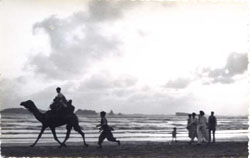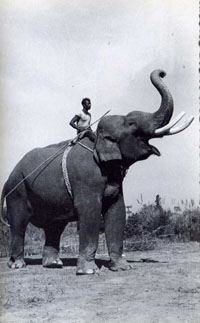Postcard Images of the Orient
Author:Emily Corbett
Columbia University professor Edward Said's landmark 1978 book Orientalism was the first piece of academic writing to describe how Western European and North American views of the Orient were based on a system of manipulation by imperial powers.1 Said called this a "style of thought based upon an ontological and epistemological distinction made between 'the Orient' and [. . .] 'the Occident'."2 While North Americans tend to associate the word "Oriental" with China and Japan, Western Europeans have a strong historical tie to the Orient as a broader region including present-day Turkey, Greece, North Africa, the Middle East and India.3 For this reason "The Orient" and "The East" refer broadly to a Western European colonial ideal. Conversely, "the West" in Said's framework conflates Western Europe and North America and is referred to as "the Occident."4 Said therefore defines of Orientalism as "a Western style for dominating, restructuring, and having authority over the Orient."5 This authority commanded by the West has become evident in many different ways over time, and art historians have been studying the multifarious field of Oriental imagery for more than 60 years.6 Images of the Orient in “Wish You Were Here: Saskatchewan Postcard Collections” depict a skewed and largely constructed Orient that appears enticing, mysterious, and dangerous.
Western artists have been interested in the opulence and strangeness of the East for hundreds of years. Middle Eastern objects and Oriental themes have featured in biblical and historical paintings,7 as well as in Baroque and French Rococo paintings.8 However, images of the Orient became more pervasive in Europe during and after Napoleon Bonaparte's invasion, and the subsequent French occupation of Egypt from 1798-1901.9 Bonaparte launched the European colonization of the Middle East, and as a result, a flow of scientists, scholars, academics and adventurers flooded into the region, eager to see for themselves what had previously only been the subject of speculation.10 However, very few painters specializing in Orientalist art had the experience of visiting the East, and most created their visions of the Orient out of studios in Paris.11
Because of the disconnect between the reality of the Orient and the European description of it, the result is that Westerners share an unreal understanding of the Orient based entirely in hegemonic power. Said describes Orientalism as the "corporate institution for dealing with the Orient -- dealing with it by making statements about it, authorizing views of it, describing it, by teaching it, settling it, ruling over it."12 If this is so, what do the images of the Orient seen in early 20th century North American postcards have to say about the place that they supposedly represent? A typical example of an image of the Orient seen in Saskatchewan’s archival postcard collections is the following image, titled "Evening In Clifton Beach, Karachi, West Pakistan."
This image evokes what the author of Orientalism in Art Christine Peltre describes as "a caprice, a voluptuous obsession, an idler's fancy."13 This image of a group of people walking along a beach at sunset seems to be a romanticized depiction of the landscape. The main exotic signifier in this image is the camel and its' rider, but the family dressed in flowing robes and the misty atmosphere of the landscape further add to the sentimentality of the scene. Because postcard images are intended for a mass market, this photo was chosen by publishers because it would surely appeal to European and North American customers. The image is perhaps intriguing to a Western viewer because it presents the known and unknown simultaneously. The photo presents a familiar-looking landscape, with the elemental simplicity of earth, air, and water all present. However, the bizarre animal and exotic clothing signify that this is a very different place from the West. This image promotes an understanding of the Orient as a distinct realm, one that exists in a distant and unfamiliar sphere.
Often, images of the Orient seen in the Western world depict the region as a lawless and barbaric land where the accepted Western code of conduct can be casually ignored (Peltre 89).14 One postcard image that illustrates the dangers of the Orient is called "Lal Bahdur / The Elephant who killed a Deputy Commissioner."
This image on its own is not particularly frightening, but the title renders it so. A Western viewer may not find a photo of an elephant to be especially exotic, but a murderous elephant that killed a Deputy Commissioner is indeed a startling notion. Furthermore, the postcard shows a local man sitting confidently atop the elephant with a spear in his hand. This man evidently is able to control and harness the power of this deadly creature, as he appears to be in league with the beast. The visual subtext of this image can be read in two ways: either the native has heroically subdued the rogue elephant, or he is waiting to unleash its murderous power. The man is either bringing peace or threatening destruction. Thus, the image on this card represents a violent, unpredictable, yet thoroughly intriguing vision of the Orient.
Another example of a mysterious and alarming postcard image of the Orient is titled "Snake Charmer, Chittagong, East Pakistan."
The character of the snake charmer has enchanted the imaginations of Westerners for hundreds of years. The snake charmer in this photograph kneels confidently before a cobra, who rises up to meet the sound of his instrument. Three figures in the background peer at the snake charmer and his seemingly precarious situation. The snake charmer is a figure alien to Western culture, whose powers are not well understood, and therefore this image presents the Orient as mystical, dangerous and alluring. This depiction of the Orient is marketable to a Western audience because it is enchanting and morbidly intriguing. However, this photo presents an Orient that is skewed and biased through the eyes of the Western world, an Orient that is in effect mythical and erroneous. Because this image exists entirely removed from any meaningful context, it presents the Orient as pure fantasy, the site of all possibilities and no real certainties.15
It goes without saying that the geographical regions Orient" and "Occident" are man-made constructs, and as such the ideas of "East" and "West" each have a long held tradition of thought, imagery, and terminology associated with them.16 Said argues that Orientalism persists because of a European cultural hegemony which disseminates the image of Europeans as superior group, and all non-European peoples as backward.17 In this way, the investigation of all things Oriental was based on a sovereign Western school of thought out of whose unchallenged superiority an Oriental world emerged.18 The postcard images in Saskatchewan’s archival collections remind us how manipulative popular images of the East can create a vision of the Orient as a mystical, mysterious, and dangerous land.
Notes
1 Said, Edward. Orientalism. Toronto: Random House, 1978.
2 Said, Edward. Orientalism. p.1
3 Meagher, Jennifer. "Orientalism in Nineteenth-Century Art". In Heilbrunn Timeline of Art History. New York: The Metropolitan Museum of Art, 2000–. http://www.metmuseum.org/toah/hd/euor/hd_euor.htm
4 Said, Edward. Orientalism. p. 2
5 Said, Edward. Orientalism. p. 3
6 Peltre, Christine, Orientalism in Art. New Yorl: Abbeville Publishing Group, 1997. p. 14
7 Peltre, Christine, Orientalism in Art. p. 10
8 Meagher, Jennifer. "Orientalism in Nineteenth-Century Art"
9 Meagher, Jennifer. "Orientalism in Nineteenth-Century Art".
10 Taboroff, June. "The Orientalists" In Saudi Arabco World. Houston.1984 http://www.saudiaramcoworld.com/issue/198406/the.orientalists.htm
11 Peltre, Christine, Orientalism in Art. p. 9
12 Said, Edward. Orientalism. p. 3
13 Peltre, Christine, Orientalism in Art. p. 9
14 Peltre, Christine, Orientalism in Art. p. 89
15 Peltre, Christine, Orientalism in Art. p. 275
16 Said, Edward. Orientalism. p. 5
17 Said, Edward. Orientalism. p. 7
18 Said, Edward. Orientalism. p. 2
Works Cited
Meagher, Jennifer. "Orientalism in Nineteenth-Century Art". In Heilbrunn Timeline of
Art History. New York: The Metropolitan Museum of Art, 2000–. http://www.metmuseum.org/toah/hd/euor/hd_euor.htm
Peltre, Christine, Orientalism in Art. New Yorl: Abbeville Publishing Group, 1997.
Said, Edward. Orientalism. Toronto: Random House, 1978.
Taboroff, June. "The Orientalists" In Saudi Arabco World. Houston.1984
http://www.saudiaramcoworld.com/issue/198406/the.orientalists.htm




